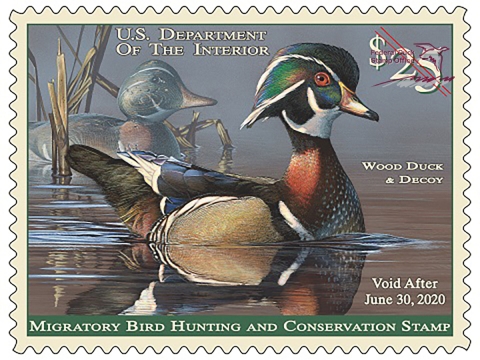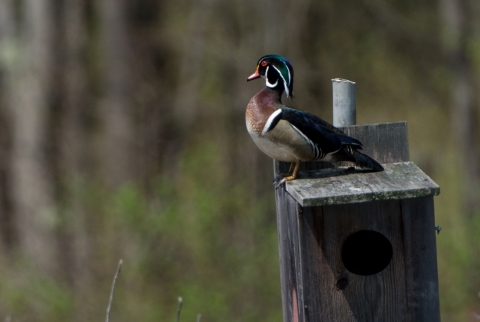Duck, Duck, Wood Duck?
Wood ducks are a common sight throughout Minnesota with an unmistakable green crest on the back of its head. A male wood duck also has bright shimmering feathers in a wide variety of colors ranging from dark green and blue all the way to white and cream. These feathers are often the most vibrant in spring and summer during breeding season before transitioning to their slightly less stunning eclipse plumage during the fall right before migration. The females of the species have much duller brown and grey colors compared to the males, but they still have a bright white teardrop marking around their eyes. Wood ducks are most often found near rivers, swamps and ponds that are surrounded by plants to provide lots of shade and places to hide. They like to nest in tree cavities and land on branches using their clawed feet, which most other duck species don’t have. The Minnesota River Valley provides the perfect habitat for these wood ducks to thrive, so much so that the wood duck has previously been used as a logo for the publicly owned land along the river corridor. Outside of the Minnesota River Valley, wood duck habitat is also found throughout most of the eastern United States and along the west coast with an estimated population of over 4 million birds. Despite their large numbers today, there was once a time when these beautiful birds were threatened near extinction.
The Birds You Never Knew
The early 1900s saw a devastating decrease in population for commonly hunted birds, including the wood duck. For many years hunting regulations were few and far between, allowing market hunters to hunt birds faster than they could reproduce. This was the perfect recipe for extinction, with the passenger pigeon being one famous example. In the early 1800s the passenger pigeon’s population was estimated as 3-5 billion, making up 25-40% of all birds in America at the time. Due to overhunting combined with habitat loss, the last known passenger pigeon died in 1914, barely a century later. While the passenger pigeon was one of the largest extinctions caused by humans, many other birds suffered a similar fate. There aren’t many records of the wood duck’s population size before the last century or so, but several scientists of the time expressed concern about wood ducks being on the brink of extinction just like the passenger pigeon. Other birds such as heath hens, Labrador ducks, Carolina parakeets and great auks suffered a similar fate to the passenger pigeon, or went “the way of the dodo” as we like to put it.
Survival of the Legally Protected
Although efforts to prevent extinction were too late for many species, there are also plenty of success stories that still live on today, with wood ducks, Canada geese and trumpeter swans being shining examples! Many of these successes are thanks to the Migratory Bird Treaty Act (MBTA), passed in 1918. This act makes it illegal to kill, capture, sell, trade or transport any migratory bird or any part, nest or egg of such a bird unless permitted. If you’ve ever been told not to pick up or collect feathers from native birds, this is likely the reason why! The MBTA works in combination with the “Duck Stamp Act”, passed in 1934, requiring hunters to purchase a duck stamp to legally hunt waterfowl. 98% of funds raised from duck stamp sales are used to buy and manage aquatic bird habitats. Together, these two acts help provide legal and financial support to bird conservation efforts and have saved millions of animals such as snowy egrets, sandhill cranes, wood ducks and plenty more from the brink of extinction.
Get All Your Duck Stamps in a Row
Despite all odds, wood ducks have proven to be a resilient species, and with the help of hunting policies and conservation efforts, have lived on to become quite a common sight today. Their numbers have stabilized enough that annual regulated hunting with the required state licensure and federal duck stamp is now allowed. Wood duck nest boxes are a large reason for this population growth, as they provide a similar structure structure
Something temporarily or permanently constructed, built, or placed; and constructed of natural or manufactured parts including, but not limited to, a building, shed, cabin, porch, bridge, walkway, stair steps, sign, landing, platform, dock, rack, fence, telecommunication device, antennae, fish cleaning table, satellite dish/mount, or well head.
Learn more about structure to the holes in trees a wood duck would naturally nest in. If you have ever seen a simple birdhouse on a pole in the middle of a pond or wetland, it could likely be a wood duck nest box and might even have baby ducklings inside! Even though wood ducks are currently thriving, many other ducks and aquatic birds are still facing challenges. Consider buying a duck stamp if you’d like to help protect and conserve these species and their habitat. You do not need to be a hunter to purchase and enjoy duck stamps. Birders, photographers and wildlife enthusiasts also benefit, as proceeds from the stamp go directly towards expanding and enhancing habitat for many threatened and endangered species, not just ducks! Duck stamps can be bought online or at many post offices, sporting goods stores and some national wildlife refuges. The art for the stamp is decided annually through a federally hosted art contest, with the winning artist’s work being featured on the stamp the following year. If you’re interested, you could always participate in this year’s art contest and maybe even get your own art featured on the stamp! The iconic wood duck has been featured on the duck stamp many times throughout the years, reminding us of its hardy nature and survival against all odds with the help of people who are committed to keeping nature’s beautiful species alive and celebrating them for generations to come.






